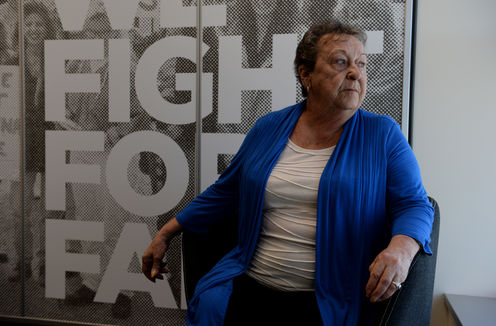
This week cancer survivor Yvonne D’Arcy had another day in court in her case against a US company’s patent on cancer genes.
Myriad Genetics was granted a patent in 1995 for isolating hereditary mutations to the BRCA1 and BRCA2 genes, which increase the carrier’s risk of developing breast and ovarian cancer.
Australia’s Federal Court last year rejected Ms D’Arcy’s appeal and ruled the patent was valid because the method of isolating the genes was an invention.
The High Court challenge is the last resort for Ms D’Arcy’s test case against companies patenting human genes and has implications for patients, clinicans and researchers’ access to genetic information.
What are these three claims about?
D’Arcy argues the full Federal Court of Australia is wrong to uphold the validity of three of the 30 claims in Australian Patent 686004. A “claim” defines the legal boundary of an “invention”, much like a certificate of title defines the legal boundary to a piece of land.
Each claim defines the “invention” to be human DNA in an “isolated” form. Isolated means that the human DNA has been removed from the human genome or has been made outside of it. Human DNA is further defined by reference to specific genetic sequences that correspond identically to the genetic sequences of mutations in the BRCA1 human gene.
The BRCA1 gene is a normal human gene that plays a critical role in controlling certain types of cancers, such as breast and ovarian cancers.
The mutations to the BRCA1 gene identified in the claims prevent this gene from performing that role effectively. The mutations specified in the “claims” are linked to much higher incidence of breast and ovarian cancers in women who have a family history of these cancers.
Why is this case before the High Court?
The High Court is the final court of appeal, but the right to an appeal is not automatic. Special leave is required. Its decision is binding on all courts in Australia, although the Australian Parliament can overrule any High Court decision by legislation.
Anyone can challenge an Australian patent in whole or in part. In the first instance, Justice John Nicholas upheld the validity of these claims in 2013. So did the full Federal Court in 2014. In February, Ms D’Arcy successfully applied for special leave to appeal to the High Court.
Ms D’Arcy argues that the subject matter of the three claims are not “inventions” and therefore are not “patentable inventions” pursuant to Section 18(1)(a) of the Patents Act 1990. This provision, which has been part of Australian patent law since the Patents Act 1903, mandates that a patent monopoly must only be granted if:
the invention, so far as claimed in any claim … is a manner of manufacture within the full meaning of section 6 of the Statute of Monopolies including the proviso …
Relying on a 1959 decision of the High Court in National Research Development Corporation v The Commissioner of Patents (NRDC) the full Federal Court held that the isolated DNA molecules are inventions because they are an “artificial state of affairs that has some discernible effect”.
The NRDC decision is the leading decision on the issue in Australia. The Federal Court is bound to follow it. The High Court is not; it can review any of its decisions by either overruling, qualifying or explaining them.
What are the implications?
The first is consistency with patent law in other countries. In June 2013 the United States Supreme Court unanimously held that the corresponding US patent claims to the same “invention” were invalid under US patent law. It did on the basis that the subject matter of the claims did not display “markedly different characteristics from any found in nature.”
It held:
… Myriad did not create or alter any of the information encoded in the BRCA1 and BRCA2 genes …
The Supreme Court overruled two US Federal Circuit decisions over the same patent claims. It also terminated a 30-year practice of the US Patent and Trademark Office.
Second, it may restrict the use of genetic information. Patent monopolies are restrictive in that they provide the patent owner with the exclusive right to operate within their intellectual property boundary for a 20-year period. Patents over isolated genes can unfairly and improperly prevent others, such as doctors, from making use of genetic information for medical applications, such as in diagnostic tests used by clinicians.
Third, it may impact on innovation and research funding. Patents cannot be ignored. They provide the owners with considerable legal rights of redress if patent rights are violated. Accordingly, any violation, including non-commercial use, even by doctors or clinicians for legitimate medical purposes, is subject to legal action in the Federal Court. The patent owner is entitled to damages or an account of profits.
Gene patents create a real and expensive obstacle to innovators. Innovators are forced to invent or negotiate around patented subject matter. This means that scarce and limited research funds that could be used for primary medical research, are increasingly being directed to dealing with the plethora of gene patents. The beneficiaries are patent lawyers and patent owners.
Fourth, it may affect the cost of access to genetic information. In the US, where Myriad did enforce its patent monopoly over BRCA1 and BRCA2 genetic mutations, the cost to women of a full genetic screening was around US$4,000. And Myriad did not share the genetic information it collected with other clinicians or researchers.
We now await the High Court’s decision on the appeal, which is unlikely to be handed down before September.
Luigi Palombi does not work for, consult to, own shares in or receive funding from any company or organisation that would benefit from this article, and has no relevant affiliations.
